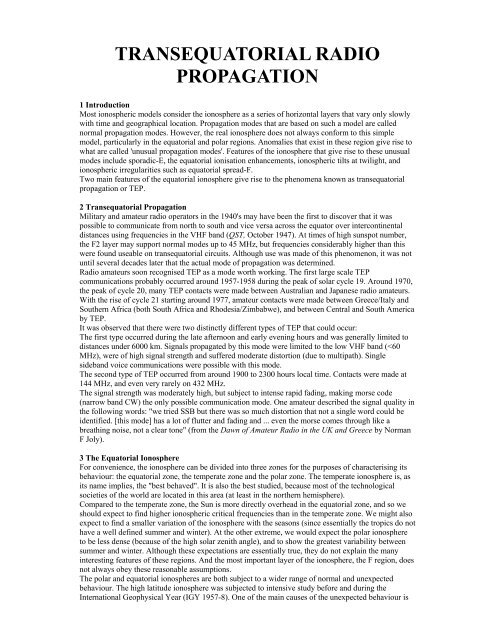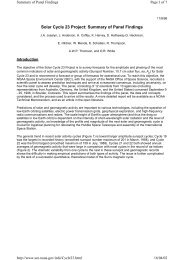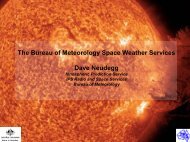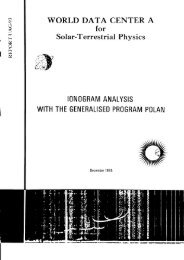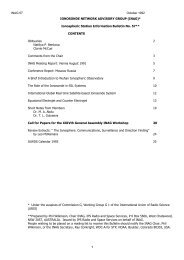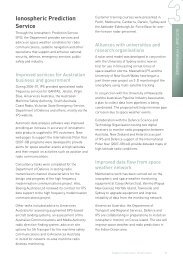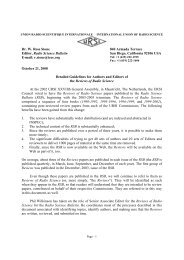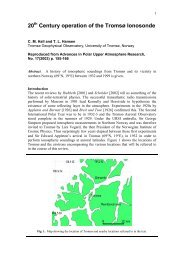Transequatorial Radio Propagation - IPS - Radio and Space Services
Transequatorial Radio Propagation - IPS - Radio and Space Services
Transequatorial Radio Propagation - IPS - Radio and Space Services
You also want an ePaper? Increase the reach of your titles
YUMPU automatically turns print PDFs into web optimized ePapers that Google loves.
TRANSEQUATORIAL RADIO<br />
PROPAGATION<br />
1 Introduction<br />
Most ionospheric models consider the ionosphere as a series of horizontal layers that vary only slowly<br />
with time <strong>and</strong> geographical location. <strong>Propagation</strong> modes that are based on such a model are called<br />
normal propagation modes. However, the real ionosphere does not always conform to this simple<br />
model, particularly in the equatorial <strong>and</strong> polar regions. Anomalies that exist in these region give rise to<br />
what are called 'unusual propagation modes'. Features of the ionosphere that give rise to these unusual<br />
modes include sporadic-E, the equatorial ionisation enhancements, ionospheric tilts at twilight, <strong>and</strong><br />
ionospheric irregularities such as equatorial spread-F.<br />
Two main features of the equatorial ionosphere give rise to the phenomena known as transequatorial<br />
propagation or TEP.<br />
2 <strong>Transequatorial</strong> <strong>Propagation</strong><br />
Military <strong>and</strong> amateur radio operators in the 1940's may have been the first to discover that it was<br />
possible to communicate from north to south <strong>and</strong> vice versa across the equator over intercontinental<br />
distances using frequencies in the VHF b<strong>and</strong> (QST, October 1947). At times of high sunspot number,<br />
the F2 layer may support normal modes up to 45 MHz, but frequencies considerably higher than this<br />
were found useable on transequatorial circuits. Although use was made of this phenomenon, it was not<br />
until several decades later that the actual mode of propagation was determined.<br />
<strong>Radio</strong> amateurs soon recognised TEP as a mode worth working. The first large scale TEP<br />
communications probably occurred around 1957-1958 during the peak of solar cycle 19. Around 1970,<br />
the peak of cycle 20, many TEP contacts were made between Australian <strong>and</strong> Japanese radio amateurs.<br />
With the rise of cycle 21 starting around 1977, amateur contacts were made between Greece/Italy <strong>and</strong><br />
Southern Africa (both South Africa <strong>and</strong> Rhodesia/Zimbabwe), <strong>and</strong> between Central <strong>and</strong> South America<br />
by TEP.<br />
It was observed that there were two distinctly different types of TEP that could occur:<br />
The first type occurred during the late afternoon <strong>and</strong> early evening hours <strong>and</strong> was generally limited to<br />
distances under 6000 km. Signals propagated by this mode were limited to the low VHF b<strong>and</strong> (
the Earth's magnetic field. In the polar regions, the magnetic field lines are almost perpendicular to the<br />
Earth’s surface, while in the equatorial region, the magnetic field lines are horizontal to the Earth’s<br />
surface at the magnetic equator. (Note: to confuse the picture even further, the geomagnetic <strong>and</strong><br />
geographic equators do not usually coincide, <strong>and</strong> they may be up to 12 degrees apart. At Asian<br />
longitudes the geomagnetic equator is the above the geographic equator, whereas at American<br />
longitudes it is below.)<br />
The most interesting feature of the tropical ionosphere is the region commonly called the equatorial<br />
anomaly. Historically, this name arose because the ionisation peak was not expected – it’s presence<br />
disobeyed the simple mid-latitude model people had devised for the ionosphere. While we now know<br />
better what causes the ionisation crests, the old name still sticks. This is where a high electron<br />
concentration is observed on each side of the magnetic equator at magnetic latitudes at around 10 to 20<br />
degrees. These crests of ionisation give rise to higher ionospheric critical frequencies (foF2) than exist<br />
at the geomagnetic equator. They are also at lower altitudes than is the peak of the F-layer at the<br />
geomagnetic equator.<br />
The equatorial anomaly is caused by the combined action of electric <strong>and</strong> magnetic fields. When the<br />
overhead sun creates intense ionisation in the region, the electric field starts these charges moving. The<br />
magnetic field (which only has an effect on moving charges) then causes them to drift upwards.<br />
Finally, the particles diffuse outwards, following the geomagnetic field down to where it intersects the<br />
normal F-layer This process starts immediately after sunrise <strong>and</strong> by mid afternoon the buildup in<br />
ionisation is clearly present <strong>and</strong> persists until after sunset, when no more ionisation is produced by the<br />
sun.<br />
During the early evening hours, while the enhanced ionisation is decreasing, vast ionisation irregularity<br />
regions can be formed by dynamic processes. It is generally thought that an instability starts low in the<br />
ionosphere, grows <strong>and</strong> propagates upward. These irregularities are blown around by ionospheric winds,<br />
breakup, <strong>and</strong> by the morning hours (0300 LT), have mostly disappeared. Generally, ionisation<br />
irregularities can be seen on an ionosonde as a thickening or spreading of the F2 layer trace. This is<br />
referred to as range or frequency spreading (depending on the mechanism involved - <strong>and</strong> it sometimes<br />
difficult to separate the two). All spreading is believed to be due to ionisation irregularities in the<br />
ionosphere. These irregularities, which (at least in the equatorial ionosphere) occur only at night-time,<br />
usually start to develop in the evening hours as a disturbance at the bottom of the ionosphere <strong>and</strong> then<br />
grow upward. They may be in the form of exp<strong>and</strong>ing plumes, <strong>and</strong>/or as small scale bubbles or pockets.<br />
They are aligned with the geomagnetic field lines (<strong>and</strong> are thus often referred to as field aligned<br />
irregularities FAI). These plumes, tubes, bubbles or pockets form holes, or biteouts in the local<br />
ionisation <strong>and</strong> radio waves are refracted by these discontinuities in the ionosphere. Not only do these<br />
irregularities affect HF radio propagation but they can also cause scintillations on L-b<strong>and</strong> (low<br />
microwave) satellite to ground transionospheric signals.<br />
The equatorial anomaly <strong>and</strong> the irregularities are used to explain transequatorial propagation.<br />
4 aTEP (Afternoon TEP)<br />
Afternoon transequatorial propagation is believed to by a super F mode (designated FF), in which the<br />
signal from the transmitter is first reflected by the concentration of ionisation at one of the equatorial<br />
anomaly crests to the second crest in the opposite hemisphere. From there it is reflected down to the<br />
ground receiving station. It thus suffers no ground reflection (as would be the case in the normal 2F<br />
mode), <strong>and</strong> it also passes through the absorptive D-layer only twice (instead of 4 times for the 2F<br />
mode).
Because the intermediate ray is between two parts of the F layer, the grazing angle at the ionosphere<br />
can be substantially smaller than for a ray reflected back to the ground. This in turn implies that a<br />
higher frequency may be reflected (fr= foF2*sec(i)). Here i is the angle of incidence at the ionosphere,<br />
<strong>and</strong> as this approaches 90 (the grazing angle g=90-i tends to zero), the maximum possible reflected<br />
frequency (fr) becomes larger. Another way of saying this is that the obliquity factor of the circuit is<br />
higher. The smaller grazing angle is also made possible because the increased ionisation at the anomaly<br />
crest follows the magnetic field lines <strong>and</strong> is tilted slightly upward toward the equator.<br />
High signal strength observed for afternoon TEP are due to the smaller number of passages through the<br />
D-layer, <strong>and</strong> because the anomaly crests support propagation of signals from a wider range of elevation<br />
angles than with usual propagation modes, the distribution of ionisation in the equatorial anomaly<br />
tending to focus these along the path.<br />
The characteristics of aTEP are:<br />
� Maximum useable frequency (MUF) up to about 60 MHz, which is usually about 15 to 25<br />
MHz above the 2F mode frequency for the same path.<br />
� Occurs from around 1500 to 1900 local time. It is more prevalent near the equinoxes <strong>and</strong> at<br />
times of high sunspot number.<br />
� Typical path lengths will be from 5000 to 6500 kilometres.<br />
� Signals will normally be strong with limited fading <strong>and</strong> distortion (from multipathing or<br />
Doppler spread).<br />
5 eTEP (Evening TEP)<br />
Evening transequatorial propagation generally supports much higher frequencies than aTEP <strong>and</strong> has, on<br />
rare occasions, been reported on the 432 MHz amateur frequency b<strong>and</strong> (low UHF). Evening TEP is<br />
strongly correlated with the existence of range spreading, called equatorial spread F, seen on equatorial<br />
ionograms. Evening TEP propagation is not as well understood as aTEP but it is believed to take place<br />
via a whispering gallery or field-guided mode which relies on the existence of ionospheric bubbles,<br />
tubes or plumes that have an electron concentration lower than the surrounding area. Rays are reflected<br />
from the surfaces of the bubble walls, at all times staying within the ionosphere until they finally<br />
emerge on a path down to the ground.<br />
The characteristics of evening TEP are:<br />
� Occurs around 2000 to 2300 local time, <strong>and</strong> is more frequent around the equinoxes <strong>and</strong><br />
especially at times of high sunspot number.<br />
� Although signal strengths are high, the signal is subject to deep <strong>and</strong> rapid fading <strong>and</strong> very<br />
strong distortion (from multipathing <strong>and</strong> large Doppler motions). Doppler spread up to 2kHz<br />
has been observed on a CW signal.<br />
� Path lengths may vary from 3000 to 8000 kilometres.<br />
� Frequencies supported are higher than for aTEP <strong>and</strong> may very occasionally rise into the low<br />
UHF b<strong>and</strong>.<br />
6 Diagnostics for TEP
It is not yet possible to predict the occurrence of TEP with any certainty, so further investigations into<br />
these propagation circumstances are required.<br />
We know some necessary conditions for TEP, but we also know that these are not sufficient to ensure<br />
that TEP will occur. Some of these are:<br />
� For the highest frequency support, the circuit should be symmetric with respect to the<br />
geomagnetic equator. That is, the receiver <strong>and</strong> transmitter should be located at equal distances<br />
from the magnetic (dip) equator.<br />
� The path must be within about 15 degrees of geomagnetic north-south.<br />
� The occurrence rate is greatest around the equinoxes.<br />
� Occurrence rate is greatest at times around the maximum of the solar cycle. This is a time of<br />
higher solar EUV output (which leads to more intense ionospheric ionisation).<br />
� Occurrence rate decreases as the circuit frequency increases.<br />
� Range spreading on equatorial ionograms appears to be a necessary but not a sufficient<br />
condition for eTEP. However, this probably depends on thestation location.<br />
� The higher the F2 layer over the geomagnetic equator the higher the occurrence rate of TEP.<br />
In fact, this is thought to be one of the best predictors for eTEP.<br />
� The further the equatorial anomaly crests are from the geomagnetic equator the higher the<br />
probability that aTEP will be present. This geometry favours enhancement of the FF mode.<br />
� Quiet geomagnetic conditions appear to favour the development of ionospheric irregularities,<br />
<strong>and</strong> thus eTEP. A 27-day periodicity has been noted on some paths (probably related to<br />
geomagnetic activity of solar origin). The higher the circuit frequency, the more important it<br />
appears to be to have quiet geomagnetic conditions. (Note: geomagnetic disturbances are<br />
usually more prevalent <strong>and</strong> more intense around the equinoxes, <strong>and</strong> thus we have two<br />
conflicting conditions).<br />
Note that some of the above diagnostics are for aTEP but many relate to eTEP.<br />
7 Australian Beacons Suitable for TEP Investigations<br />
The ideal beacon for TEP investigations is a continuous wave (CW) transmitter. This allows<br />
measurements of signal strength, Doppler shift <strong>and</strong> spread, to be made without any confounding factors<br />
introduced by the signal modulation. Failing a CW beacon, an AM transmitter is the next best<br />
substitute, as the carrier is a fixed frequency <strong>and</strong> relatively constant in power (although the total<br />
radiated power may be constant, the ratio of energy spread across carrier <strong>and</strong> sideb<strong>and</strong>s may change).<br />
An FM transmitter is normally not appropriate as a TEP beacon (although the total radiated power is<br />
constant, this is spread over a wide frequency range [eg 250 kHz], <strong>and</strong> there is no energy peak at the<br />
nominal carrier frequency when significant modulation is present).<br />
The list of Australian beacons shown below have been chosen as potential c<strong>and</strong>idates for Australia-<br />
Japan TEP investigations.<br />
AMATEUR RADIO BEACONS<br />
Callsign Location Lat Lon Freq Power Direction Modulat<br />
VK8VF Darwin -12 131 28.268 40W Omni CW<br />
VK8VF Darwin -12 131 50.056 100W Omni CW<br />
VK8VF Darwin -12 131 144.480 30W Omni CW<br />
AUSTRALIAN TELEVISION TRANSMITTERS (Video Carrier only)<br />
Callsign Location Lat Lon Freq Power Direction Mod/Pol<br />
RTQ0 MtMowbulla<br />
n<br />
-27 151.5 46.171875 492kW Omni AM/Horiz<br />
TNQ1 Bowen -20 148 57.25 13kW Omni AM/Horiz<br />
ABMQ2 Clermont -22.5 148.3 64.198 820W ? AM/Vert<br />
ABNQ2 Dunk Is -18 146 64.24 328W ? AM/Vert<br />
ABQ2 Shute<br />
Harbour<br />
-20.2 148.8 64.26 525W ? AM/Horiz<br />
TNQ2 Gordonvale -17 145.8 64.198 1639W Omni AM/Horiz<br />
ABNQ2 MtGarnet -17.7 145 64.25 39W ? AM/Horiz<br />
8 For further information<br />
• Leo F McNamara, The Ionosphere: Communications, Surveillance, <strong>and</strong> Direction Finding,<br />
Kreiger (Orbit Books) 1991, ISBN 0-89464-040-2.
Material prepared by John Kennewell <strong>and</strong> Phil Wilkinson. Copyright by <strong>IPS</strong> <strong>Radio</strong> & <strong>Space</strong> <strong>Services</strong>,<br />
Sydney, Australia. All rights reserved.<br />
Comments or suggestions can be directed to education@ips.gov.au


